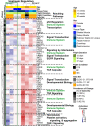A microRNA signature and TGF-β1 response were identified as the key master regulators for spaceflight response
- PMID: 30044882
- PMCID: PMC6059388
- DOI: 10.1371/journal.pone.0199621
A microRNA signature and TGF-β1 response were identified as the key master regulators for spaceflight response
Abstract
Translating fundamental biological discoveries from NASA Space Biology program into health risk from space flights has been an ongoing challenge. We propose to use NASA GeneLab database to gain new knowledge on potential systemic responses to space. Unbiased systems biology analysis of transcriptomic data from seven different rodent datasets reveals for the first time the existence of potential "master regulators" coordinating a systemic response to microgravity and/or space radiation with TGF-β1 being the most common regulator. We hypothesized the space environment leads to the release of biomolecules circulating inside the blood stream. Through datamining we identified 13 candidate microRNAs (miRNA) which are common in all studies and directly interact with TGF-β1 that can be potential circulating factors impacting space biology. This study exemplifies the utility of the GeneLab data repository to aid in the process of performing novel hypothesis-based research.
Conflict of interest statement
All authors declare no competing financial interests and conflict of interest with the data and information in this manuscript.
Figures







References
Publication types
MeSH terms
Substances
LinkOut - more resources
Full Text Sources
Other Literature Sources

